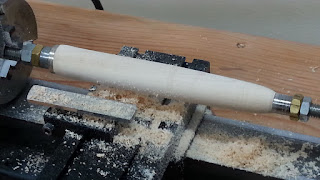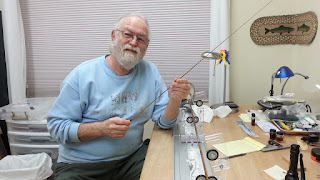What Now?
Embarking on new passions with bamboo and the fishing arts. Creating angling tools from my mind, my heart and my hands with craftsmanship and raw materials. Swimming in the bamboo vortex as it were, learning and sharing with like minded around the world and along the creek...
Tuesday, May 28, 2024
Monday, December 24, 2018
Rattan handles
Been a little busy in the rod shop working on some new handles made with rattan
Roughing wood blanks to wrap with rattan
Hood inserted to check fit
Reel seat with cap & band set inserted in back of handle blank
Rattan wrapped around 3" stove pipe then flamed for effect. Pre-wrapping also gives the rattan a 'set' in circular pattern to make wrapping easier.
Wrapped and comparing blanks
Couple different sizes of rattan used, 3mm and 2.5mm
Wrapping silk thread wound in the hollows between wraps to give the handle 'depth'
Finished little soldiers waiting for rods to be made!
Saturday, March 11, 2017
Sunday, June 19, 2016
Ferrule Lapping Tool
This
tool is used to get even lapping across the entire slide area of a fly rod
ferrule. When ferrule sets are ordered, many suppliers offer to size and lap in
the male ferrule to fit the female ferrule. With a two tip rod you have two
male ferrules that need fitting. If you have a three piece, two tip rod you are
making then you have three male ferrules that need sizing and fitting to the
female ferrules.
Many
fly rod makers prefer to fit their own ferrules. Ferrules are usually supplied
at .001'' oversize to the ID of the female ferrule, and this needs to be worked
down so it will fit snug inside the female. A little 'pop' sound is emitted
when properly fitted ferrules are pulled apart.
You
can fit your ferrules before or after gluing them to the fly rod blanks. Many
find fitting them before the gluing process easier than trying to manage the
length of the sections (blanks) while trying to fit the ferrules after they
have been glued on.
This
tool is designed to provide even pressure on the entire length of the slide
area of the male ferrule to prevent tapering or uneven sizing of the slide area
during the fitting process. By applying even pressure on the sand paper along
the entire length of the male slide area you take the same amount of material
off the ferrule as you approach the desired outside diameter.
Use
400 grit wet or dry sand paper initially to remove the bulk of the material off
the slide area of the ferrule and when the female ferrule just barley fits onto
the end of the male ferrule, start using 600 grit wet or dry sand paper until
female ferrule fits onto the male but still quite tightly. Applying a little
light oil to the wet or dry sandpaper makes the removal of material a little
easier.
Switch
to 1000, 1200 or even 1500 sandpaper to get the final tight fit to the
male/female ferrule then polish with a little metal polish applied to fine 0000
steel wool.
This
ferrule lapping tool is made of hardwood (Oak) and all the supplies were
purchased at our local ACE Hardware store.
3/4x1-1/2
inch oak hardwood strip cut in half the wide way (end up with 3/4x3/4x3 inch
blocks)
1/4-28x3
or 4 inch screws (2 each)
Medium
pressure springs (2 each)
1/4
inch flat washers (4 each)
3/32
inch steel rods
1/4-28
wing nuts
150
grit sandpaper
400,
600 & 1200 grit sandpaper
thin
flat washer for spacing
Cut
3 inch length block from the hardwood.
Cut
lengthwise so you have 2 equal width pieces. Sand if necessary.
Mark
"IN" on two uncut surfaces, These will be the surfaces facing each
other when completed. These should fit cleanly together with no gap.
Place
the marked "IN" surfaces one on top of the other in a machinist vise
to keep then secure during the drilling phase.
Mark
and drill 2 holes with a #8 drill 3/4'' in from the outer edge. This is the
correct drill size for 1/4-28 tap but since this is wood and not steel, I
wanted a tighter fit for the 1/4-28 screws that will be used. Drill clear
through both blocks.
Re-drill
through top block only with a 1/4 inch drill bit.
Push
1/4-28 tap through top block (some resistance will be noted so twist the tap
through top block holes) and tap threads clear through the bottom block.
Mark
and drill 2 holes with a #43 (.089) drill 1'' in from the outer edge for the
alignment pins. Don't drill clear through the lower block. Leave approximately
1/4''. These pins also serve to hold the sand paper in place during operation.
Remove
the top block.
Cut
2 each 3/4'' lengths off the 3/32'' dowel rod and grind each to a slight point.
Using a vise, press each one into one hole of the top block and the other into
the opposite hole on the lower block. These pins will be used to keep the
blocks in alignment and will help hold the sandpaper in place as you use the
tool.
Use
a 3/32'' drill bit in a hand vise to drill out the opposing hole in the top
block and bottom block to receive the alignment pins.
Trial
fit the two blocks together. You may use a rat tail file on the 1/4'' holes to
allow the blocks to fit together smoothly. You may also apply dry soap to the
screw threads and dowel pins to aid in smoother sliding the blocks together and
apart.
Place
a shim of a couple thicknesses of heavy sandpaper (I used 150 grit with a
thickness of .0272'' total) between the blocks. This will give you some working
clearance during operation of the tool.
Assemble
the blocks together laying on their side in the drill press. Drill a hole
through the middle of the two block halves with the sandpaper sandwiched
between them. To determine what size bit
to use depends on what size ferrules you wish to fit together.
You
will be using two thicknesses of sandpaper along with your male ferrule in the
hole for honing. 600 wet or dry is approximately .00785'' thick so twice that
is .01563''. Add this thickness to the OD of your male ferrule (IE: #14 =
.25219'' before removing material) you drilled hole should be .2678'' or
17/64'' for closest diameter.
Example:
to make a tool to fit #14 ferrules (14/64'') use a 17/64'' drill bit, and for a
#11 ferrule (11/64'') use a 13/64'' drill bit.
Remove
drilled block from machinist vise after drilling honing hole, disassemble and
remove shimming sandpaper.
Insure
blocks separate and close together smoothly.
Cut
3/4'' wide strips of 400, 600 and 1200 wet or dry sandpaper to use in your new
tool. Cut these into short strips that will punch over the two dowels and
extend into the half hole of each block (see photo).
At
this point it is a good practice to mic the OD of the male ferrule and record
this dimension. after a few rotations of the tool against your ferrule, you
will want to measure the OD again to determine how much material you are
removing.
Assemble
the tool squeezing the male ferrule between the blocks against the sandpaper.
Install the springs, washers and wing nuts.
Screw
the wing nuts down against the springs to apply sanding pressure to the
ferrule, but only minimally.
Slide
shim washer over the male ferrule. The ID of the shim should be small enough to
stop at the inside end of the slide length. This shim is used to prevent the
tool from riding up over the slide and onto the shoulder of the ferrule.
You
may operate the tool manually around the circumference of the ferrule or mount
the ferrule in a lathe to apply the rotational force as the tool hones to
outside diameter. Stop often to check that the honing process is removing the
same amount of material along the entire length of the slide area on the
ferrule. Also try to fit the female onto the male ferrule to determine the
tightness of the fit.
CAUTION: Approach the removal of the material from the
slide of the male ferrule slowly and try to fit the female ferrule often to
achieve the desired fit. You can accidently remove too much material off the
slide of the male ferrule rendering it too loose to use on your fly rod!
Friday, April 29, 2016
'Sally Hansen Sand Turtle Gleemer'
Today I learned how others are getting such smooth and flowing wraps on their bamboo fly rods. I recall seeing an article in the 'Planing Form' issue I received recently by Tony Spezio about these 'gleemers'.
I learned these fine ladies fingernail tools were being employed by rod builders to file, smooth and polish the varnished guide wraps and the blanks as well. I decided to give this a try on my wraps, which I felt I had enough coats of dried urethane on my wraps to safely sand them smooth without cutting into the thread.
I was amazed at the results! After cleaning off the sanded dust and applying a thinned urethane coat to the wraps the appear super smooth and delightful.
This video is of the butt section with sanding and varnish overcoat applied
This video shows the sanded wraps ready for the varnish overcoat
This video shows sanded wraps after diluted varnish overcoat has been applied
Monday, April 25, 2016
Monday, April 4, 2016
Presentation finally made...
Yesterday was the day Geri and I finally presented our next door neighbor lady with her surprise bamboo fly rod!
I made this one for her over the winter as a surprise gift including a rod sock, rod tube, Redington Surge fly reel loaded with backing, line, leader and tippet.
She was ecstatic and loved the way it cast right off... Hopefully she will share with us the first time she catches her first fish with it. She normally goes out fishing with her son and his wife. They all seem to have a great time!
This lady has done so much for us, giving us here newspapers and sharing her garbage bin as well. We also find fresh baked cookies by our rear door often as well.
Thank you, Lynn for being such an enjoyable neighbor!!!!
Subscribe to:
Comments (Atom)


















































